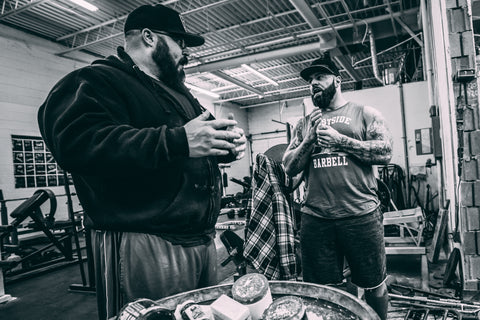Starting Conjugate: Rack Pulls

One of the reasons the Conjugate Method is so efficient is that it allows us to implement exercise variations with the intent of developing strength that will carry over to a specific competition lift. Instead of entering a new "phase" of training designed to improve our weaknesses, we can add exercise variations to address identified issues as soon as the next training session.
The deadlift is a lift that requires significant amounts of brute force and explosive power. However, if you wish to become as strong as possible in the deadlift, it is vital to include variations of the deadlift as a max effort main exercise or your accessory work. At Westside, one of our preferred ways to address a specific deadlift weakness is through the use of rack pulls.
The rack pull is an exercise that allows us to train at specific joint angles based on the pin height. Joint angle-specific training will enable us to set up an exercise that places a lifter in positions and ranges of motion that they struggle with the most. Conversely, we can use the rack pull to put a lifter in an advantageous position, allowing a lifter to train around an injury.
This makes the rack pull a valuable deadlift variation, given that you can use it to challenge or assist you. However, a few issues can arise when you decide to perform rack pulls.
You first need to consider the equipment you'll be using. Be sure to use a bent barbell and an older rack if possible. You do not want a gym owner walking up and seeing you rack pulling with a $400 deadlift bar while beating the shit out of their brand new rack. The second issue you can run into is the overuse of the rack pull, leading to unreliable deadlift training feedback.
Joint angle-specific exercises can be a blessing or a curse to a lifter. As we mentioned above, when utilized correctly, training at specific joint angles will allow the weak lifter to gain strength in specific ranges of motion or help the injured lifter continue to train max effort lower within tolerable ranges of motion.
You become cursed by these exercises when you decide to use them for the wrong reasons. When implementing the rack pull, chances are you will be able to handle heavier weight than you can off the floor (depending on bar height), which causes many lifters to begin using the rack pull to inflate their ego.
Here is how we program the rack pull into our training at Westside Barbell:
Main Exercise
You want to work up to a single repetition when using rack pulls as the main exercise. Unless you use rack pulls due to injury, you will want to set the barbell pins where you experience the most difficulty in the deadlift. For instance, set the barbell slightly below the knee if you struggle at the knees. If you struggle off the floor, put the barbell at the mid-shin level.
Additionally, you may want to add some accommodating resistance to your rack pulls. This will lead to improved absolute strength and explosive power in the ranges of motion you struggle with the most.
Regarding frequency, we recommend using the rack pull as a max effort lower exercise once per month. If you are injured and using the rack pull to continue training, we advise adding in as much variation to your rack pulls that your injury will allow.
Accessory Exercise
The rack pull can significantly benefit your absolute strength, explosive power, and muscle mass when used as an accessory exercise. At Westside, we most frequently use rack pulls as an accessory exercise designed to build strength and muscle mass.
Considering a max effort single is not the goal here, we generally place the barbell around mid-shin to bring the hamstrings into the movement as much as possible. This allows us to reap the posterior chain benefits of deadlifting without dealing with the recovery times associated with deadlifting off the floor (rack pulls are similar to mat pulls; they are easier to recover from).
Typically, rack pulls will be included in a lower body accessory workout at least once per week. We often rotate bars and accommodating resistance as well. One week may consist of rack pulls vs. minibands, and the following week may include axle bar rack pulls at knee level.
An ideal rack pull setup should target a lifter's identified posterior chain weakness.
Problems and Solutions
The path to becoming as strong as possible will be littered with problems to solve. As you evolve and become stronger, you will encounter different weaknesses and issues with your lifts. How strong you can become will ultimately boil down to your ability to identify weaknesses and intelligently address them using special exercises.
Today, many individuals wrongly believe that the only way to become stronger and more proficient in the squat, bench, and deadlift is to perform the squat, bench, and deadlift constantly. However, this approach almost always leads to lagging strengths or overuse injuries.
The human body reacts to new training stimuli much faster than the same old stimulus every week. A lifter must do more than vary their volume and intensity to avoid accommodation. You can specifically address your weaknesses and accelerate your gains by implementing special exercise variations.
Sources:
Simmons, L. (2007). Westside Barbell Book of Methods. Westside Barbell.
Verkhoshansky, Y., & Siff, M. C. (2009). Supertraining. Verkhoshansky.





